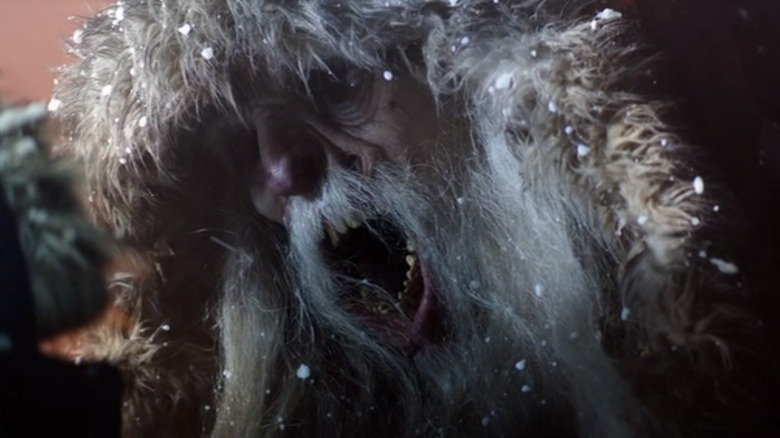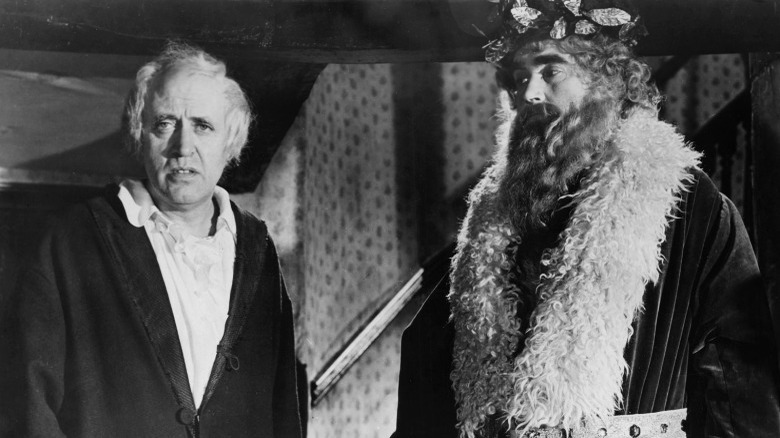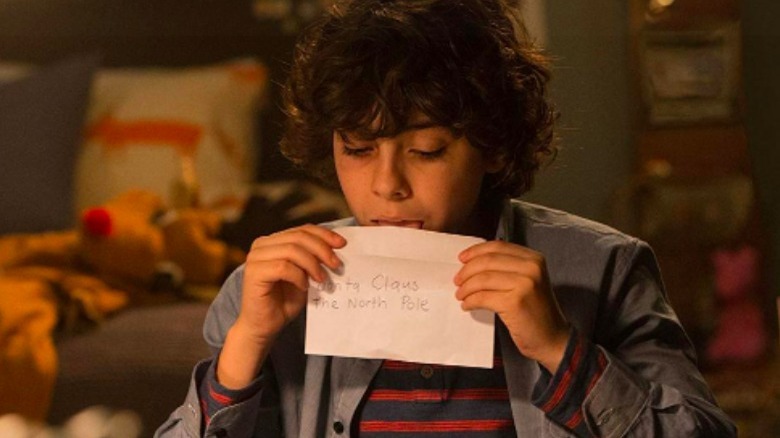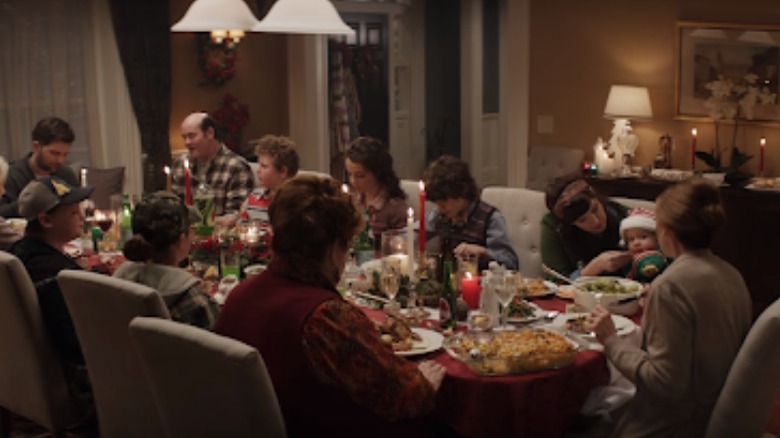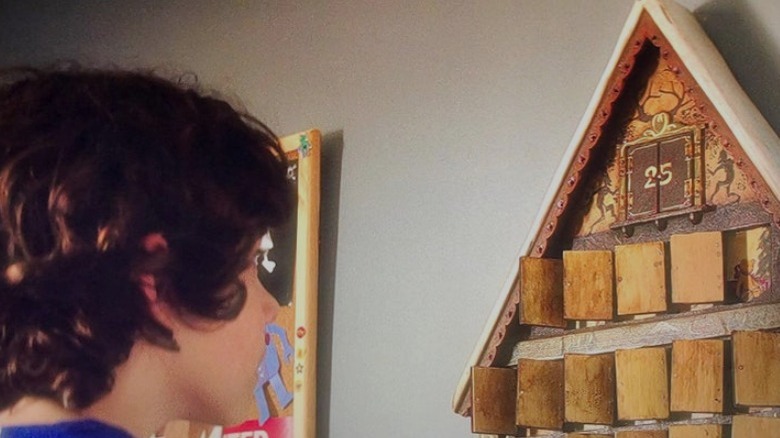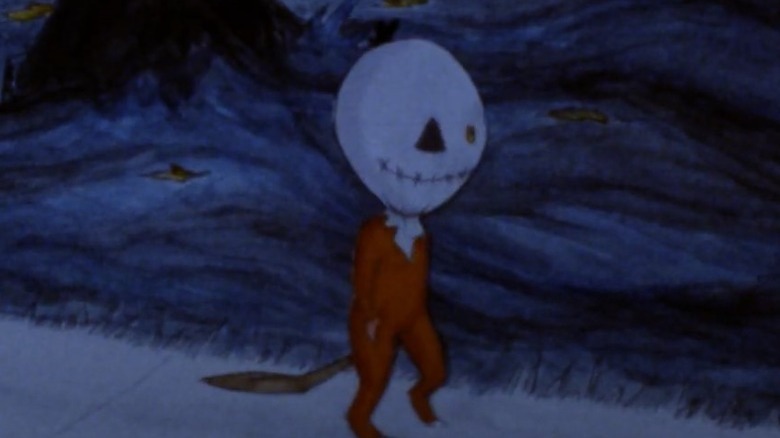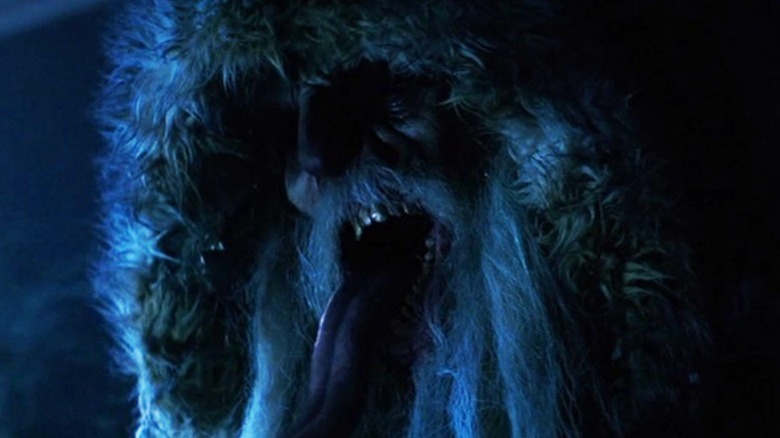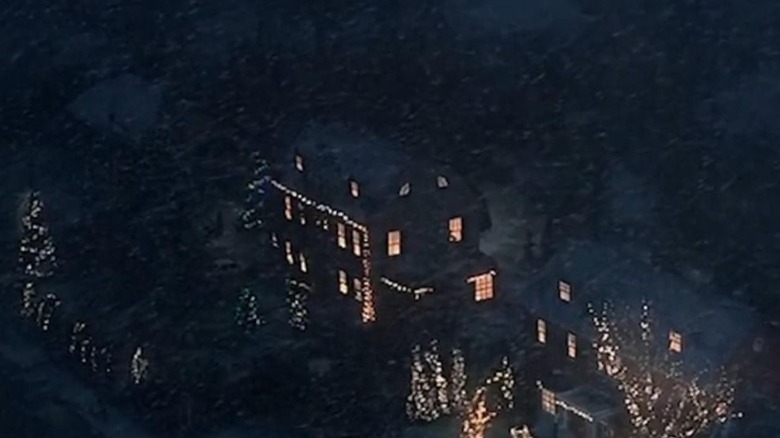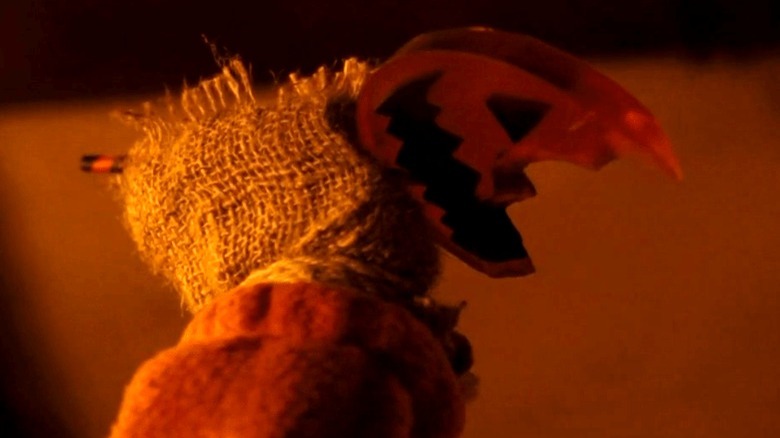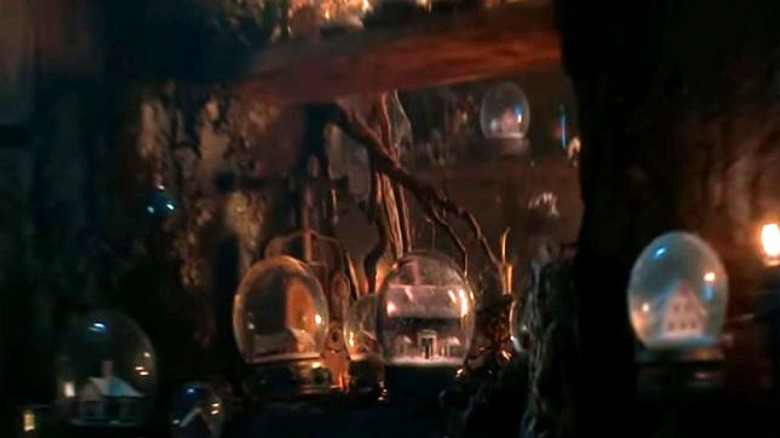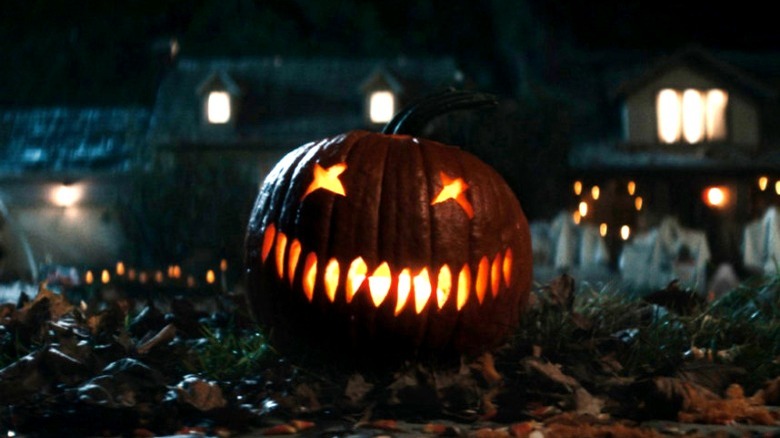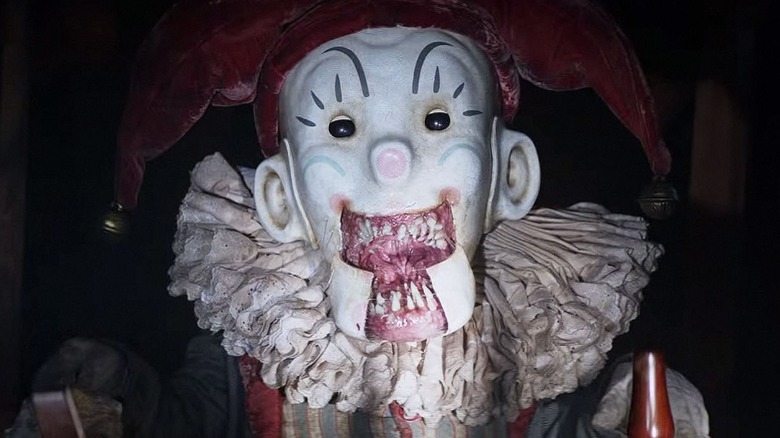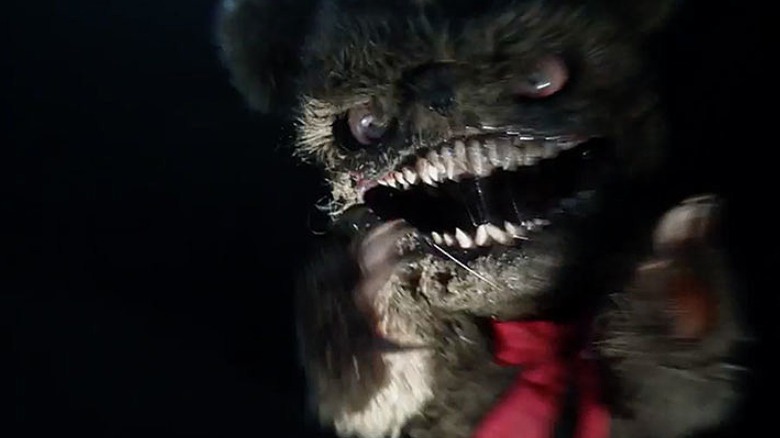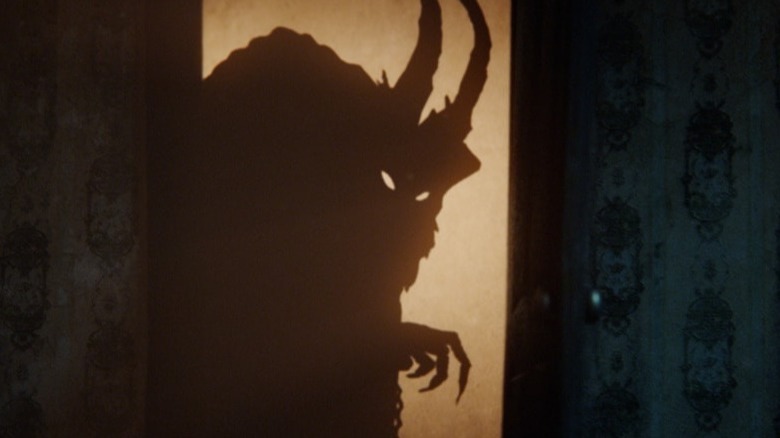Things In Krampus You Only Notice After Watching It More Than Once
Thanks to filmmaker Michael Dougherty, the horrors of Halloween don't have to end every October 31. Adapted from German folklore, Dougherty's 2015 cult classic "Krampus" injected Christmas with a dash of the cinematic horrors, demons, and creatures that plague All Hallow's Eve.
Krampus isn't a mere demon, mind you — he's a tormenter hailing from the deepest, darkest bowels of hell, on a quest to wreak punishment on the cruel, vindictive, and greedy among us. If German myths were to be believed, a lump of coal for your awful misdeeds would be a cakewalk compared to what the Krampus would impose.
Following on the heels of the Dougherty holiday cult film "Trick 'r Treat," this one moved its seasonal terrors to the month of December. Similarly stuffed with dark humor, campy delight, and monster mayhem, like "Trick" it came with lessons warning viewers to honor and cherish their holiday traditions.
"Krampus" had a demon terrorizing an awful family, who despised one another and feigned familial platitudes in an effort to keep up appearances. Therein lies the dark humor that elicits as many chuckles as shrieks of terror as contemptible people receive just desserts that are far worse than figgy pudding. The flick also has a lot going on beneath the surface, little details you may not have noticed upon first viewing. With that in mind, here's a festive breakdown of the holiday horrors buried beneath "Krampus."
A Christmas Carol playing on the television is foreshadowing
"Krampus" is the tale of a family that has lost its way, as far as the spirit of Christmas is concerned. They are uncaring, selfish, and unabashedly cruel to one another. It's time for the titular monster to teach them a lesson.
The film begins with an ironic, humorous display of the seasonal spirit — of chaos, rather than warmth — as shoppers are seen brawling over consumer goods, the primary character Max Engel (Emjay Anthony) introduced as he is walloping another youngster in a scuffle during a Christmas recital. Clearly, the point of the Christmas holiday is lost on these people.
As we enter the Engel home, Max's grandmother Omi (Krista Stadler) is baking enough sweets to feed a small town, while the 1951 version of "A Christmas Carol" starring Alastair Sim as crotchety Ebenezer Scrooge plays on the small kitchen television. Viewers who have already seen the film once understand that Omi has a high regard for the holiday spirit, and the film is a simple reminder to her of what could happen when people lose that spark and turn on each other. "A Christmas Carol" acts, then, as a foreshadowing of what's in store for the Engels.
Just as Ebenezer Scrooge had to experience the pain he caused and witness the terrifying reality of a dark future, the Engel family will also have to embrace horrors they've brought upon themselves for stoking conflict and bitterness.
In Max's room, Pacific Rim toys and other franchises are referenced
It's not unheard of to use the setting of a child's room as an opportunity for a filmmaker to share Easter eggs of his work or connections to other films or properties. In the original "Poltergeist," "The Princess Bride" and "ET," the children's rooms are filled with posters and toys referencing everything from "Star Wars" to "Alien."
Multiple items are similarly scattered throughout young Max's room in "Krampus." Since the movie is produced by Legendary Pictures, it makes sense the boy would have a toy figure of a Jaeger from "Pacific Rim" on his desk. On his bulletin board, countless handmade items can be seen scattered amongst things like a "Rick and Morty" poster. Max is also, apparently a fan of the video game "Minecraft," as merchandise can be seen sitting on his dresser.
The first act of the film is like a traditional Christmas movie
"Krampus" was designed to avoid horror at the outset, which only makes it scarier; it begins, instead, as a traditional family Christmas movie. In the commentary track (available on the DVD and Blu-ray), these and other insights lay out a gameplan that included making the film's first act reminiscent of dysfunctional families in Christmas staples such as "Home Alone" and "National Lampoon's Christmas Vacation."
Once Max's Christmas spirit breaks entirely and he shreds his letter to Santa Claus, the film then takes its sharp left turn, heading squarely towards the horror realm and taking the viewer with it, into unexpected territory. This particular Christmas classic is powered by a family every bit as dysfunctional as the Griswolds and McCallisters — but this time, the family fall victim to the horrors they so rightly deserve — giving the viewers a chuckle, and perhaps a bit of catharsis as well.
Max's advent calendar is the same one seen in Omi's animated flashback
While "Krampus" is often played for fun, laughs, and a few frights, there are a few subtleties that anchor the overall themes of the story. One involves a key element of Christmas, the advent calendar.
In the middle of the film, Omi (Krista Stadler) tells the family of her past experience with the darkness known as Krampus, represented through a beautifully animated flashback. As a young child, she lived in a village whose occupants had descended into bitter selfishness. Her parents cast a dark shadow on her youthful Christmas experience one that caused her to turn her back on the Christmas spirit (much like Max), casting her Santa doll into the fire. That night, Krampus came for her family and dragged them to the depths of hell, leaving her alive to forever remember what had transpired.
When Omi sits frightened in her bed, eagle-eyed viewers can spot Max's same exact advent calendar hanging on the wall of her bedroom. Of course, this means that Max obtained his advent calendar from his grandmother — and it acts as a symbolic framework of the three different acts, also segmented by the period of three days in which the film takes place.
Omi's animated flashback also highlights the Krampus bell she received from the demon. That same bell is then gifted to Max by the Krampus in the final moments of the film, reminding him and the rest of the family that darkness will once again emerge if they return to their callous ways.
A TV broadcast in the background references Dougherty's first short film
Fans of Dougherty's "Trick 'r Treat" may be aware that film's main character Sam was conceived while he was in film school, as he created his first animated short. Called "Season's Greetings," it can be viewed in the extras on Blu-ray copies of the film, or on Dougherty's official YouTube channel.
In the short, Sam can be seen as a lonely trick-or-treater on Halloween, seeking out some sweet loot. When he seemingly gets assaulted in an alley by an adult stalker, somehow the mysterious little tike bests the man and emerges from the alley with the body now in his trick-or-treat bag.
In "Krampus," there is a reference to "Season's Greetings" early, when the Engel family returns from Max's disastrous recital. As "A Christmas Carol" plays on the kitchen television, Max's dad Tom (Adam Scott) changes the channel to a news broadcast that contains a banner with the text "Season's Greetings." While it might seem like a simple holiday message to uninitiated viewers, since this is a Dougherty film, it's just the filmmaker making a clever reference to his past.
The dead human face of the Krampus is a mask
The origins of the Krampus are steeped in mystery. Omi states that the beast had been doing his dirty work for thousands of years. When we finally have a chance to see the Krampus up close, however, it looks like a hulking, ragged corpse of an old man (at least, in the face).
But in actuality, the demon's face doesn't exactly line up with the rest of his features, which include curving demonic horns and hairy legs with hooves. That's because the face of the old man — a twisted play on Santa Claus — is not actually the real face of the Krampus.
To make the lore behind the story that much darker, the filmmakers confirmed in the film commentary that the face of the Krampus is another person's face, which the demon wears as a mask. If you study the creature's facial features, you can see that his eyes are goat-like in appearance, and there is a lining around his eyes that indicate the skin is not his own. This explains why the jaw is agape.
What does the Krampus truly looks like? Perhaps that's territory for a sequel. But if the goat eyes, hooves, and horns are any indication, he likely looks somewhat akin to the Satanic visage of Baphomet.
The Amityville Horror house can be seen in Max's neighborhood
Michael Dougherty considers himself a true horror fan, and clearly enjoys making references to the films that have inspired his love for horror and Halloween. "Krampus" continues that trend.
Within the film, sharp-eyed fans can see some of that horror DNA emerge in the neighborhood where the Engels live. The only scene of "Krampus" to actually be shot on location was the opening at the retail store (which was filmed in New Zealand); the rest was shot on a production stage. Therefore, the wide shots of the neighborhood during the blizzard are digitally created.
Because the exterior of the Engels' home and the neighborhood at large are the product of computer animation, Dougherty and his team could theoretically build whatever neighborhood they wanted. So, the "Amityville Horror" house appears to be the Engels' next-door neighbors, and if you look closely you can see the two iconic quarter-moon windows at the top of the house.
According to Bloody Disgusting, Dougherty has said that other famous homes exist in these shots too, including the Michael Myers house from "Halloween" and even Ferris Bueller's home. While those ones might be harder to find, it likely won't stop film enthusiasts from pausing the film for a bit of "Where's Waldo?" home edition.
Max shares his leftover Halloween candy, complete with Sam's lollipop
On December 7, 2021, the "Naughty Cut" edition of the film was released, which adds approximately four extra minutes of content originally left on the cutting room floor for the theatrical release. Ultimately, this acts as Dougherty's true director's cut. Fans of "Trick 'r Treat" will be pleased with one scene, it seems, in particular, that helps to further establish Sam and Krampus exist in the same universe.
While the family is huddled in the living room during the power outage, Max fetches a box containing his leftover Halloween candy. Despite the torment his cousins put him through, Max's kind heart has him sharing some of the goodies with them. When he opens the box, the recognizable jack-o'-lantern lollipop carried around by Sam can be seen. Who knows? Perhaps Sam and Krampus hang out at the same Underworld bar, shooting the breeze and comparing body counts every now and again.
The Psycho house can be glimpsed in the snow globes
Much as the neighborhood shots include homes made famous by horror films, Dougherty didn't stop there. In the final act of "Krampus," the Engel family find themselves enjoying Christmas together, uncharacteristically civilized. Max awakens to find his family in good spirits, having seemingly forgotten about the events that transpired the night before. After Max receives a mysterious gift in the form of a Krampus bell, however, the details of their harrowing, demon-dodging evening come rushing back.
The camera then pans out to show that the family's home now exists inside a snow globe in the hellish domain of the Krampus. There are numerous other snow globes littered throughout the cave as well, each with homes inside them.
Once again, a viewer with a quick "pause button" finger will be rewarded. At one point, you might spot the home of one of the original slashers, Norman Bates from "Psycho," inside one of the snow globes. Apparently the Krampus either captured the raving psycho, or he's simply keeping an eye on him. Either way, humanity is thankful.
The fictional town from Trick 'r Treat is referenced in the weather advisory
"Krampus" hints at a world beyond the cabin fever experienced by the Engle family — but whether this is all some alternate reality meant to terrorize the Engels, or whether Krampus really did invade the neighborhood may never be known.
If you take the film on its surface level, the entire community was desolate, aside from the frozen corpse of a delivery driver. In the "Naughty Cut" of the film, it's clear that the blizzard affected a large area — and a radio weather advisory explains just how far the snow stretches.
One of the towns listed in the advisory is Warren Valley — a fictional town in Ohio and Sam's old stomping grounds. Therefore Principal Wilkins, the werewolves, the undead children from the bus accident, and more would seem to reside somewhere in the vicinity of Max and the Engel household.
The monsters were all practical effects, except for the gingerbread men
Just like the classic horror films of the '80s, Dougherty wanted to create a sense of realism with the monstrosities at play in the film. Therefore, the team employed practical effects whenever possible.
Almost everything on the movie set — from the snow (made from the same material as diapers) to the creatures that lurked in the halls of the Engels home (all hand-crafted) were made to look and feel real, the film commentary explains. Dougherty employed Weta Workshop to help with the designs of the creatures, which ranged from the ravenous teddy bear to the terrifying jack-in-the-box clown that swallowed Jordan whole.
Even the big man himself, Krampus, was a hulking costume completely designed from head to toe as a practical effect. Aside from the animated gingerbread men and the aforementioned aerial shots, everything else was very real.
You can hear the Wilhelm scream
One of Hollywood's longest-running inside jokes, the Wilhelm scream (which originated in the 1951 film "Distant Drums"), can be found in "Krampus."
The piercing, two-second shriek of a man falling to his death (or being attacked, or in pain — its versatility is why it has endured so long) has had its audio re-purposed in an estimated 400 movies over the years. The name is derived from one of those early occurrences, 1953's "Charge at Feather River," where it was attributed to an ill-fated character by the name of Private Wilhelm.
Eventually, the sound effect circulated through Hollywood enough to become a stock effect, used as the go-to scream, particularly for characters befalling bad turns of fate off-camera. Films that have utilized the scream include "Star Wars" (in virtually every iteration up to "Episode VII"), "Indiana Jones and the Temple of Doom," "Game of Thrones" and even the videogame "Red Dead Redemption." Fun fact: it is believed that the voice of the scream belongs to none other than the late Sheb Wooley, singer of the 1958 novelty hit "The Purple People Eater."
As for "Krampus," you can hear old Private Wilhelm during an explosive scene where the parents understand the nature of the horror that has befallen them, and they are attacked by several demonic toys. During the ensuing attack, listeners can hear the Wilhelm scream when the teddy bear is tossed over a railing.
Omi implies that Krampus is the dark side of Saint Nicholas
Krampus is a mysterious creature, one clearly of hellish origin. But it makes you wonder why this demon is tied to Christmas, in particular. Why doesn't he punish, say, those who lose their Arbor Day spirit?
In the film, he's depicted as a twisted mirror image of Santa Claus. He wears the same red coat lined with fur, and carries a sack full of gifts that are secret devices meant to torment the unsuspecting. Instead of joy and giving gifts, he simply takes. Why would Santa, in all his magical glory, take kindly to a demon that runs amok staining his legacy by wreaking horrors on the individuals of the naughty list?
Omi offers a simple idea, one that might explain the very nature of the beast. In this world, she says, Krampus is Saint Nick's shadow — the dark side of the Santa Claus coin. While he may be a separate entity from Santa, he may also be intrinsically tied to the jolly Christmas mascot, rampaging as his darker half.
A lot is still unknown about Dougherty's version of the Krampus demon. With any luck, Legendary Pictures will greenlight a sequel at some point in the near future, so audiences can learn even more about this enigmatic character who will make you want to hide under your tree.
